Main menu
Common skin conditions

NEWS
Join DermNet PRO
Read more
Quick links
Morphoea — extra information
Morphoea
Author: Dr Amanda Saracino, Dermatologist, Alfred Health and Melbourne Dermatology Clinic, Melbourne, VIC, Australia. DermNet Editor-in-Chief A/Prof Amanda Oakley, Dermatologist, Hamilton, New Zealand. September 2017.
Introduction
Demographics
Causes
Clinical features
Morphology
Symptoms from morphoea
Diagnosis
Treatment
Monitoring treatment response
Natural history
What is morphoea?
Morphoea (American spelling, morphea) is characterised by an area of inflammation and fibrosis (thickening and hardening) of the skin due to increased collagen deposition. It is also known as localised scleroderma. The term 'scleroderma' covers various types of morphoea and systemic sclerosis.
Subtypes of morphoea vary according to the location of involved skin. Any subtype of morphoea can also result in deep or subdermal involvement of the underlying fat, fascia, muscle, or bone.
Unlike systemic sclerosis, morphoea does NOT cause:
- Skin thickening of the fingers and toes (sclerodactyly)
- Specific autoantibodies in the blood (such as an anti-centromere antibody or anti-Scl70)
- Abnormal small blood vessels in the fingers (nail fold capillaries)
- Fibrosis and/or vascular damage to internal organs.
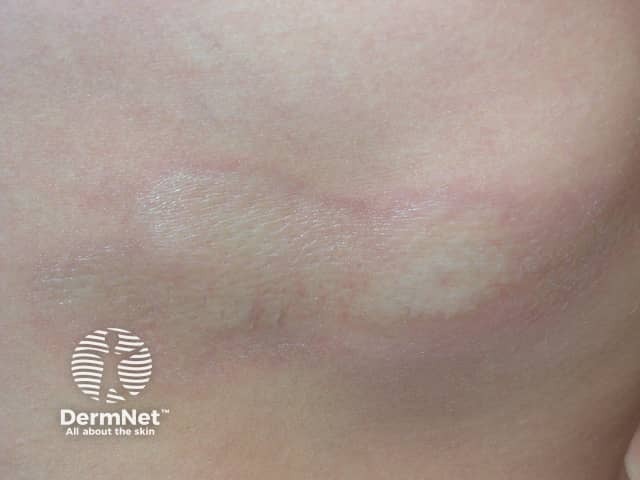
Morphoea
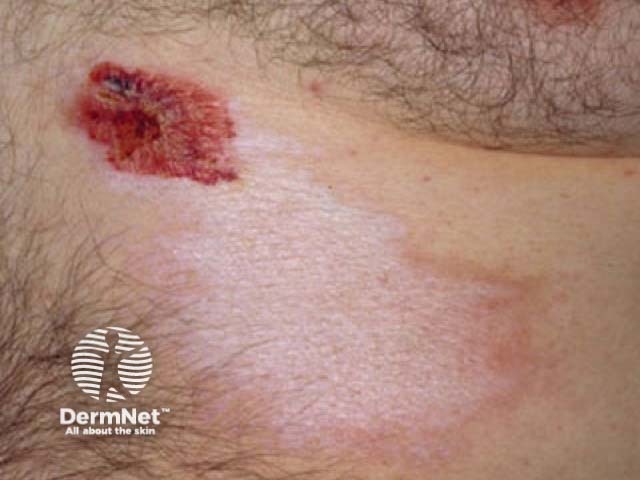
Morphoea
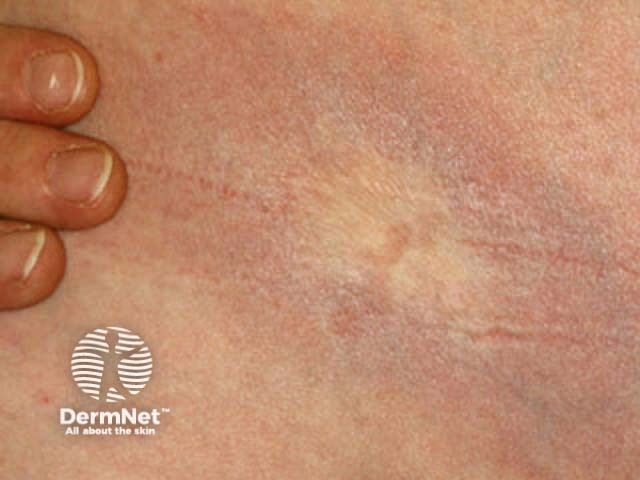
Morphoea
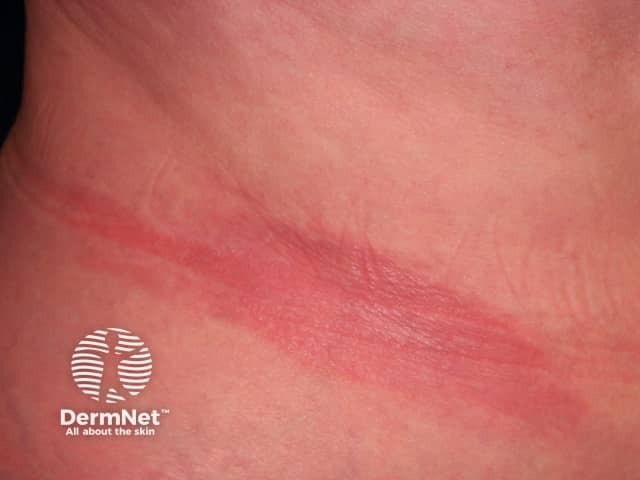
Morphoea
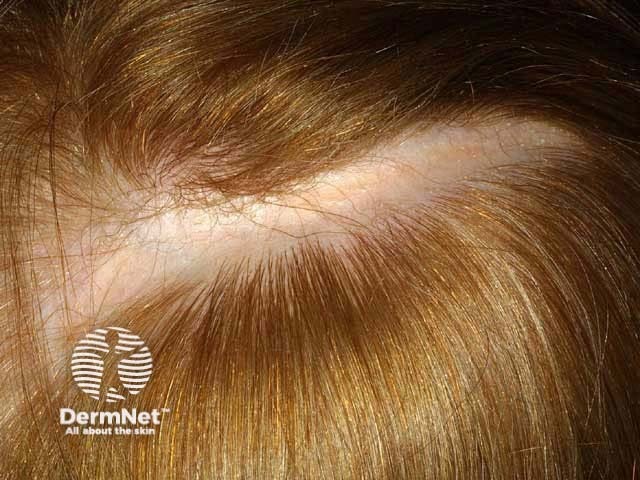
Morphoea
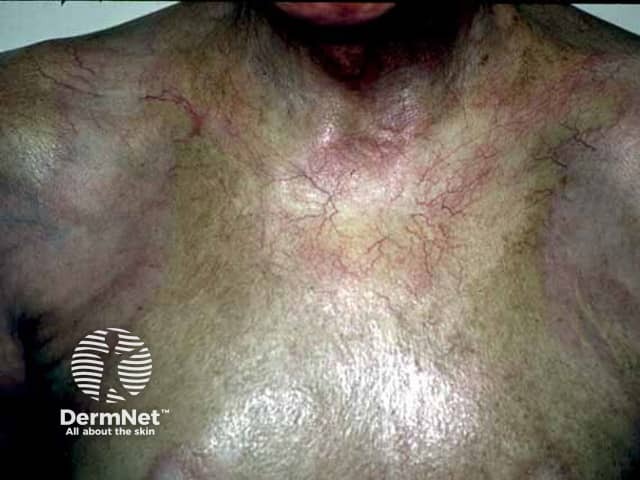
Morphoea
Who gets morphoea?
Morphoea is rare and is estimated to have an incidence of 1–3 per 100,000 children. It is three times more common in females compared to males and often begins in childhood. Although not an inherited disorder, certain HLA subtypes (HLA-DRB1*04:04 and HLA-B*37) are associated with an increased risk of morphoea.
What is the cause of morphoea?
The precise cause of morphoea is unknown.
- Localised genetic factors appear to play a role; for example, cutaneous mosaicism may important in linear morphoea, which follows Blaschko lines of epidermal development.
- Up to 40% of patients with severe forms of morphoea have a personal or family history of autoimmune disease (eg, thyroid disease, vitiligo) or rheumatologic disease (eg, rheumatoid arthritis).
For unknown reasons, morphoea often develops after an external trigger such as:
- Insect bite or tick bite (the role of Borellia burgdorferi, cause of Lyme disease is controversial)
- Injection (eg, bleomycin, silicone) or vaccination
- Repeated friction
- Surgery
- Radiotherapy
- Penetrating wound
- Extreme exercise
- Repeated minor friction along the waistband, bra strap and inguinal region, in isomorphic disseminated plaque morphoea.
Trauma-related morphoea may occur at the affected site, or at unrelated distant sites.
What are the subtypes and clinical features of morphoea?
When describing morphoea, consider three features.
- Anatomical distribution: location and whether limited, linear, generalised or mixed
- Morphology: inflammatory, sclerotic, dyspigmented or atrophic
- Depth of tissue involvement: skin, fat, fascia, muscle, bone
Anatomical distribution
Subtypes of morphoea are limited, linear, generalised or mixed.
Limited plaque morphoea
- The most common type in adults
- Oval shaped patches of 1 to 20cm in diameter
- Two or fewer body sites.
Rare types of limited plaque morphoea include guttate morphoea and atrophoderma of Pasini and Pierini.

Morphoea

Morphoea

Morphoea
See more images of morphoea ...
Linear morphoea
- Most common subtype in children
- Found on the limbs, trunk or head (craniofacial)
- Follows lines and swirls called Blaschko lines
- Usually unilateral, but may be bilateral and widespread in severe cases.
Linear atrophoderma of Moulin is a rare subtype of atrophic and pigmented linear morphoea.
Craniofacial linear morphoea was previously sub-classified as:
- En coup de sabre (linear atrophic band +/- sclerosis, classically on the forehead or scalp)
- Parry Romberg / progressive hemifacial atrophy (atrophy of the fat, muscle and bone +/- dyspigmented +/- sclerotic changes, affecting one side of the face).
These types of craniofacial linear morphoea occur together and vary based on morphology and depth of tissue involvement.
Linear morphoea

Morphoea
See more images of morphoea ...
Generalised morphoea
Generalised morphoea affects three or more body sites. There are two major patterns;
- Disseminated plaque morphoea: scattered plaques with intervening unaffected skin. Can be isomorphic (occurring at sites of friction such as the waistband, bra line, and inguinal creases) or non-isomorphic (scattered plaques at any site).
- Pansclerotic morphoea: circumferential, confluent sclerosis, which is usually rapidly progressive and affects most of the body surface area. This occurs in childhood (disabling pansclerotic morphoea of childhood), and adulthood (when it overlaps with eosinophilic fasciitis).
- Generalised morphoea spares the digits and periareolar skin.
Pansclerotic morphoea of the chest

Morphoea
See more images of morphoea ...
Mixed pattern morphoea
- Mixed pattern morphoea occurs when more than one anatomical subtype is present.
- The most common mixed pattern is linear morphoea of a limb, with limited plaque morphoea on the trunk.
Limited morphoea is considered mild, while linear morphoea and generalised morphoea are more severe subtypes. The depth of tissue involvement is also important when assessing disease severity; subdermal involvement implies more severe disease.
Morphology
The specific appearance of morphoea varies, and may include:
- An inflammatory phase: pink, purple or bruise-like patches
- Sclerosis: the skin becomes hard, thickened, bound down, shiny, ivory white and may have a purple border of surrounding inflammation
- Dyspigmention and atrophy. This develops after a variable time period (usually months or years); hyperpigmentation is more common than hypopigmentation. Superficial (dermal) atrophy is seen as shiny skin, often with visible blood vessels. Deeper atrophy affecting fat, muscle or bone presents as concave indentations or discrepancies of limb circumference.
Morphoea classically passes through each of these morphological stages, this does not always occur.
Deep tissue involvement in morphoea
Any subtype of morphoea can affect connective tissue under the skin, such as the fat, fascia, muscle, bone, joints, or rarely brain (in craniofacial linear morphoea). Deep tissue involvement is a marker of severe disease.
When the fascia (the connective tissue under the fat layer) is involved:
- The skin can look puckered, with a cobblestone or orange peel appearance (peau d’orange)
- There may be guttering along blood vessels (the groove sign).
Involvement of bones or joints results in loss of bony tissue, pain and/or restricted joint movement (contractures).
Eosinophilic fasciitis is a form of pansclerotic morphoea with deep fascial involvement. Circumferential inflammation and sclerosis of the fascia (the connective tissue beneath the fat) frequently co-exists with overlying dermal sclerosis or other anatomical subtypes of morphoea indicating it is debatable whether it should be considered a separate condition.
Symptoms from morphoea
Morphoea may be asymptomatic, or symptoms may arise from the skin or deeper tissues, or they may due to extracutaneous manifestations.
Symptoms due to skin changes
- Some patients experience itch and/or pain from actively inflamed areas of morphoea.
- Adnexal structures are destroyed by sclerosis. This is of particular relevance in linear morphoea of the scalp, which results in permanent hair loss.
- Sclerosis can entrap superficial nerves and result in pain, tingling, and sometimes mild weakness.
Symptoms due to deeper tissue involvement
- Deep involvement over joints causes joint pain or limited joint movement (contractures).
- Constriction of the chest wall in generalised pansclerotic morphoea can result in shortness of breath.
- Teeth and jaw involvement in craniofacial linear morphoea can cause oral and dental problems. Temporomandibular joint involvement causes difficulty chewing, jaw locking, or pain.
- Skull and/or brain involvement can cause headaches or in some rare cases, neurological symptoms such as nerve palsies or seizures.
Systemic symptoms
Up to 30% of patients with more severe types of linear or generalised morphoea can have extracutaneous non-specific inflammatory symptoms. These include:
- Fatigue, lethargy
- Non-specific joint pain and/or inflammation (arthralgia, arthritis)
- Muscle pain
- Reflux/heartburn
- Raynaud phenomenon (cold hands with red/white/blue colour changes)
- Eye dryness, irritation or blurred vision due to ocular involvement (most commonly episcleritis, anterior uveitis, keratitis) – related or unrelated to the site of morphoea
These extracutaneous manifestations imply that morphoea is a systemic inflammatory condition. In contrast, systemic sclerosis results in direct damage and fibrosis of the lungs, heart, kidneys, and/or gastrointestinal tract — which do not occur in morphoea.
How is morphoea diagnosed?
The diagnosis of morphoea is often made clinically, without the need for further tests. Biopsy, blood tests and imaging may be undertaken if the diagnosis or extent of disease is unclear.
Skin biopsy
A skin biopsy enables the skin, subcutaneous fat (and sometimes fascia) to be examined under the microscope. Classic findings in morphoea include:
- Sharply squared-off biopsy (‘cookie-cutter’ sign)
- Atrophic epidermis
- Thickened, hyalinised collagen, with possible loss of appendageal structures (such as sweat glands and hair follicles)
- Fat loss / entrapment
- Inflammatory cell infiltrate (lymphocytes +/- plasma cells).
Blood tests
- Eosinophil count (can be raised)
- Inflammatory markers (ESR or CRP may be raised)
- Anti-nuclear antibody (may be raised, but systemic sclerosis specific ENA antibodies such as anti-Sc70 are negative)
- Thyroid function tests (can be abnormal; consider if at risk of associated autoimmune thyroid disease)
- Rheumatoid factor or anti-CCP antibodies if arthralgia/arthritis (may be raised)
Imaging
Magnetic resonance imaging (MRI) may be performed to assess how deep the morphoea extends beyond the skin, for example in generalised morphoea, linear morphoea crossing joints, and craniofacial linear morphoea.
How is morphoea treated?
There is no cure for morphoea. Treatment is aimed at halting ongoing disease activity and progression.
Topical therapy
Topical therapy may help limited and superficial forms of morphoea and can reduce the itch.
Phototherapy
Phototherapy can soften morphoea and has anti-inflammatory effects.
Different wavelengths of ultraviolet radiation can be used.
- UVA1 penetrates most deeply and is hence useful when deeper subcutaneous tissues are involved, but is rarely available.
- Topical or systemic photochemotherapy (PUVA, ie, psoralen + UVA) may be helpful.
- Narrowband UVB is less effective, as it only penetrates superficially.
Systemic treatment
Systemic treatment is intended to prevent progression and switch off the active disease process. It is usually needed for at least 2 to 4 years, but relapse can occur.
Specific treatment decisions in morphoea are guided by the subtype of morphoea and its severity.
Superficial limited morphoea — mild
- Topical therapy
- Phototherapy (UVA1, nbUVB, PUVA)
Superficial generalised or adult-onset linear morphoea — moderate
- Topical therapies AND phototherapy
- Systemic therapy
Deep forms of morphoea and paediatric onset linear morphoea — severe
- Methotrexate +/- systemic corticosteroids (IV pulsed &/or oral)
- Mycophenolate mofetil +/- corticosteroids (IV pulsed &/or oral)
- Combination therapies
- Combine 1st and 2nd line treatments
- Add hydroxychloroquine
- Add phototherapy (UVA1 or PUVA if available)
Other options
- Ciclosporin
- Abatacept
- Tocilizumab
- Extracorporeal photopheresis
- Other experimental and reported therapies
Physiotherapy to improve joint mobility should be undertaken with caution in active morphoea, as the resultant trauma may potentially act as an ongoing disease trigger.
In some cases, surgery may be of benefit, such as autologous fat transfer, to improve atrophy.
Monitoring treatment response
Disease progression and treatment response can be monitored using photographs, the localized scleroderma cutaneous assessment tool(LoSCAT) and other highly specialised tests, such as infrared thermography.
Localised scleroderma cutaneous assessment tool
LoSCAT is a validated tool used to assess disease activity and damage over time. It assesses 16 body sites and includes two LS domains.
- The modified Localized Scleroderma Severity Index (mLoSSI), which measures disease activity
- The Localized Scleroderma Damage Index (LoSDI), which measures damage.
Scoring for mLoSSI
- Erythema: 0: no erythema; 1: slight erythema/pink; 2: red/clearly erythema; and 3: dark red or marked erythema/violaceous.
- Skin thickness: 0: normal skin thickness and freely mobile; 1: mild increase of thickness, mobile; 2: moderate increase of thickness, impaired skin mobility; 3: marked increase of thickness or no mobility of skin.
- New lesion/lesion extension: new lesion development and/or enlargement of an existing lesion within the past month (score of 3 if present).
Scoring for the LoSDI
- Dermal atrophy: 0: normal skin; 1: mild skin atrophy, i.e. shiny skin; 2: moderate atrophy, i.e. visible blood vessels; and 3: severe skin atrophy, ie, obvious ‘cliff-drop’ sign.
- Subcutaneous atrophy: 0: normal subcutaneous thickness; 1: flattening; 2: obvious concave surface; and 3: severe subcutaneous fat loss (> 2/3 loss).
- Dyspigmentation: assessing both hyper- or hypopigmentation, whichever is most prominent: 0: normal skin pigment; 1: mild; 2: moderate; and 3: severe dyspigmentation.
What is the natural history of morphoea?
Morphoea can follow a protracted course, which can be relapsing and remitting, or chronically active. Milder forms of the disease tend to become inactive within 3–5 years.
Relapse can occur after successful treatment, especially in morphoea that begins in childhood.
Extended courses of systemic treatments of 4 to 5 years or more may be required to minimise the risk of relapse.
References
- Kelsey C, Torok K. The Localized Scleroderma Assessment Tool (LoSCAT): Responsiveness to Change in a Pediatric Clinical Population. Journal of the American Academy of Dermatology. 2013;69(2):214–220. DOI:10.1016/j.jaad.2013.02.007. PubMed Central
- Arthur M, Fett NM, Latour E, et al. Evaluation of the Effectiveness and Tolerability of Mycophenolate Mofetil and Mycophenolic Acid for the Treatment of Morphea. JAMA Dermatol. 2020;156(5):521–8. DOI:10.1001/jamadermatol.2020.0035. Journal
On DermNet
Other websites
- Scleroderma — Medline Plus
- Raynaud and Scleroderma Association
- Morphea — Medscape Reference
- Morphoea — British Association of Dermatologists
